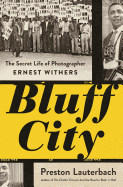
 Delving into the life of Memphis photographer Ernest Withers, popular historian Preston Lauterbach (Beale Street Dynasty) offers readers a new vantage point on a pivotal time in United States history. His fastidious research, storytelling skills and passion for the subject make Bluff City an engrossing, fascinating biography that reads like an espionage thriller.
Delving into the life of Memphis photographer Ernest Withers, popular historian Preston Lauterbach (Beale Street Dynasty) offers readers a new vantage point on a pivotal time in United States history. His fastidious research, storytelling skills and passion for the subject make Bluff City an engrossing, fascinating biography that reads like an espionage thriller.
Withers began his informal training in photography as a teenager, using his sister's boyfriend's discarded Brownie 127 camera. In the army, he received a formal education in the art and its related technology as part of his basic training. And when he deployed to the South Pacific during World War II, Withers and his fellow shutterbug, the unit's chief supply officer, picked up a side gig taking pictures for soldiers to send home to their sweethearts and parents. During his enlistment, "He'd seen no combat, fired no weapons, and shot only his fellow Americans--with a camera. He returned home as a resourceful, technically adept picture taker, versed in the craft of photography and the art of the hustle."
Withers served a short stint as one of the first African-American police officers in Memphis, but fate intended him to be behind the lens of a camera. He opened a studio at the corner of Beale and Hernando, "the vaunted Main Street of Black America" and began a Forrest Gump-like parade through a litany of celebrities. He photographed rhythm and blues musicians like Ruth Brown, B.B. King and Ray Charles, as well as a then-unknown young white man by the name of Elvis Presley. Withers defied a judge and snapped the now iconic image of Mose Wright identifying J.W. Milam while seated in the courtroom during the Emmett Till murder trial. Following the Montgomery boycott, he rode an integrated bus with a young Martin Luther King, Jr., photographing him with Ralph Abernathy.
As the civil rights movement gained momentum in the United States and Winters embedded himself in the struggles of the African-American crusade, he contributed to the dissemination of the stories as told through his images. What no one saw in those pictures, however, was the man whose father advised him at a young age "not to fuss about social change but to obey the law"; the conservative veteran who felt allegiance to his country; the husband and father supporting nine children; the photojournalist who functioned as a confidential informant for the FBI. Through a deep-dive into the events of this period and the mysterious man and his emblematic work, Lauterbach evaluates the dichotomy of Withers--a division that led him to support J. Edgar Hoover in his campaign to neutralize King. Withers's credo was "The Pictures Tell the Story," and Lauterbach allows them to tell as much of the photographer's story as possible. He fills in the remainder with stellar narrative skills.
Bluff City is emotionally stirring. Lauterbach expertly blends the passions of the period with the seeming betrayal of a hero. He details the complexities of the man and the movement, bringing out all the shades of gray necessary to understand the whole picture. This is a snapshot of U.S. history taken from a rare perspective, and the accompanying photographs from Withers's estate perfectly enhance Lauterbach's writing. --Jen Forbus, freelancer
Shelf Talker: A popular historian digs into the complex legacy of an iconic photographer from the civil rights movement who served as a spy for the FBI.

